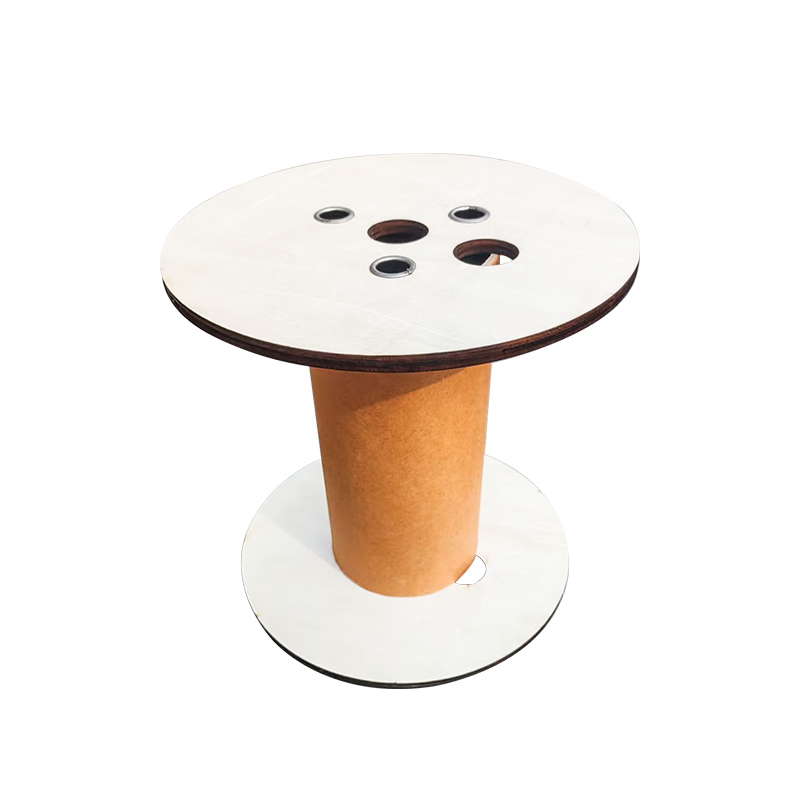May 12, 2025
Plywood cable reels is widely used for storing and transporting various types of electrical, fiber-optic, and industrial cables. However, as a wood-based product, plywood is inherently susceptible to moisture absorption, which can lead to swelling, delamination, fungal growth, and loss of structural integrity. To mitigate these risks, manufacturers apply a variety of chemical, mechanical, and thermal treatments to enhance the reel's resistance to moisture and prolong its usable life in both indoor and outdoor storage conditions. The following are the most commonly employed treatments:
1. Use of Waterproof Adhesives in the Plywood Manufacturing Process
Moisture resistance begins at the foundational level of the plywood itself. High-quality plywood used in cable reels is typically bonded using water-resistant adhesives such as phenol-formaldehyde (PF) or melamine-urea-formaldehyde (MUF) resins. These thermosetting resins are designed to maintain adhesive strength even under prolonged exposure to humidity, rain, or temperature fluctuations. Compared to standard urea-formaldehyde adhesives, PF and MUF significantly reduce the risk of delamination, which is a common failure mode when plywood is exposed to moisture over time.
2. Weather-Resistant Surface Coatings and Film Overlays
To further protect the outer surface of the cable reel, manufacturers often apply weather-resistant coatings. These can include:
Alkyd-based paints, which form a semi-flexible, water-resistant film that adheres well to wood and provides basic protection against rain and condensation.
Polyurethane coatings, which offer a more robust and abrasion-resistant barrier, particularly suitable for reels used in construction or outdoor environments.
Bituminous or asphalt-based coatings, which are sometimes applied to the inner surfaces or edges of the flanges to protect against standing water and ground contact.
Phenolic or melamine film overlays (commonly known as film-faced plywood), which provide a dense, smooth, and non-porous finish that resists water penetration. This type of coating is particularly effective for reels destined for export or long-term storage in unconditioned environments.
3. Edge Sealing for Vulnerable Surfaces
The exposed edges of plywood, where the cross-section of the laminated veneers is visible, are the most vulnerable to moisture ingress. To address this, edge sealing is performed using various compounds such as:
Epoxy resins, which provide a hard, impermeable coating that bonds well with the plywood layers.
Wax emulsions, which are cost-effective and easy to apply, offering short- to medium-term moisture resistance.
Waterproof wood sealers, often based on synthetic resins or silanes, which deeply penetrate the wood fibers and form a hydrophobic barrier.
Edge sealing is often applied immediately after machining (such as cutting or drilling) to prevent water from entering through fresh, uncoated edges.

4. Fungicide and Anti-Microbial Treatment
In damp storage conditions, plywood is prone to biological degradation such as mold, mildew, and fungal attack. To prevent this, surfaces can be treated with fungicidal preservatives. Common chemicals include:
Boron-based compounds, which are effective against a broad range of fungi and are commonly used in water-soluble wood preservatives.
Copper naphthenate or quaternary ammonium compounds (quats), which are more durable and often used in applications where extended protection is required.
These treatments not only enhance the reel’s resistance to microbial decay but also reduce the risk of odor, discoloration, and material softening.
5. Thermal Conditioning and Moisture Content Control
Another preventive approach involves kiln drying or thermal treatment of the plywood before reel assembly. This process reduces the initial moisture content of the wood to stable levels (typically between 8–12%), minimizing the likelihood of dimensional changes or microbial growth during storage. In some cases, heat-treated wood is also compliant with ISPM 15 regulations for international shipping, which is important for cable reels intended for export markets.
6. Water-Repellent Sealers and Hydrophobic Agents
In addition to structural coatings, water-repellent sealers may be applied to enhance surface resistance without significantly altering the appearance or weight of the reel. These products are often silicone-, siloxane-, or wax-based formulations that form a breathable, hydrophobic layer. While not as durable as film overlays, these sealers are effective for short-term outdoor exposure and reduce water absorption from dew, rain, or ambient humidity.
7. Protective Storage Practices and Logistics Considerations
Although not a treatment applied to the reel itself, protective storage practices play a critical role in maintaining the moisture resistance of plywood reels. These include:
Wrapping the reels in plastic film or shrink wrap to protect against moisture ingress during transit.
Storing reels off the ground using pallets or skids to prevent capillary moisture uptake.
Stacking reels under cover in ventilated storage areas to allow air circulation and avoid condensation.
Proper packaging and storage are especially important in maritime shipping, where plywood reels may be exposed to salty air and fluctuating humidity levels.